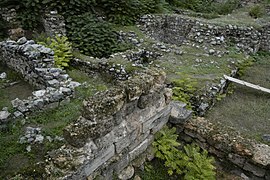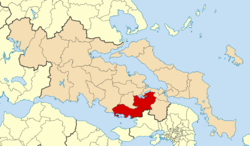Thebes (Greece)
|
Thebes Θήβα |
|
|---|---|

Remains of the Cadmea, the central fortress of ancient Thebes
|
|
| Coordinates: 38°19′N 23°19′E / 38.317°N 23.317°ECoordinates: 38°19′N 23°19′E / 38.317°N 23.317°E | |
| Country | Greece |
| Administrative region | Central Greece |
| Regional unit | Boeotia |
| Area | |
| • Municipality | 830.112 km2 (320.508 sq mi) |
| • Municipal unit | 321.015 km2 (123.945 sq mi) |
| Elevation | 215 m (705 ft) |
| Population (2011) | |
| • Municipality | 36,477 |
| • Municipality density | 44/km2 (110/sq mi) |
| • Municipal unit | 25,845 |
| • Municipal unit density | 81/km2 (210/sq mi) |
| Community | |
| • Population | 22,883 (2011) |
| • Area (km2) | 143.889 |
| Time zone | EET (UTC+2) |
| • Summer (DST) | EEST (UTC+3) |
| Postal code | 32200 |
| Area code(s) | 22620 |
| Website | http://www.thiva.gr |
Thebes (/ˈθiːbz/; Ancient Greek: Θῆβαι, Thēbai, Greek pronunciation: [tʰɛ̂ːbai̯];Modern Greek: Θήβα, Thíva [ˈθiva]) is a city in Boeotia, central Greece. It played an important role in Greek myths, as the site of the stories of Cadmus, Oedipus, Dionysus and others. Archaeological excavations in and around Thebes have revealed a Mycenaean settlement and clay tablets written in the Linear B script, indicating the importance of the site in the Bronze Age.
Thebes was the largest city of the ancient region of Boeotia and was the leader of the Boeotian confederacy. It was a major rival of ancient Athens, and sided with the Persians during the 480 BC invasion under Xerxes. Theban forces ended the power of Sparta at the Battle of Leuctra in 371 BC under the command of Epaminondas. The Sacred Band of Thebes (an elite military unit) famously fell at the battle of Chaeronea in 338 BC against Philip II and Alexander the Great. Prior to its destruction by Alexander in 335 BC, Thebes was a major force in Greek history, and was the most dominant city-state at the time of the Macedonian conquest of Greece. During the Byzantine period, the city was famous for its silks.
...
Wikipedia


